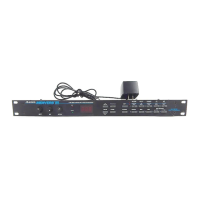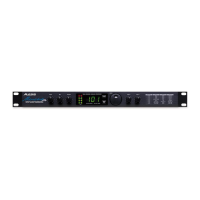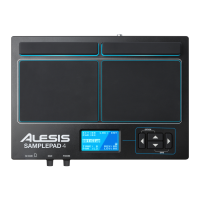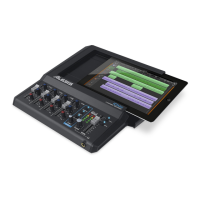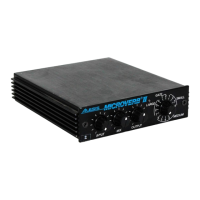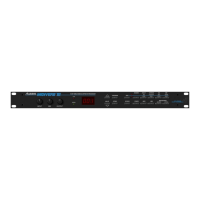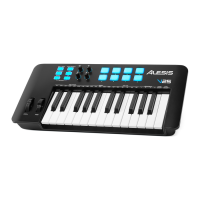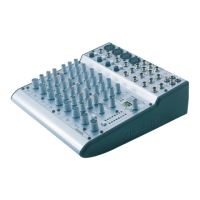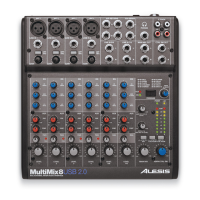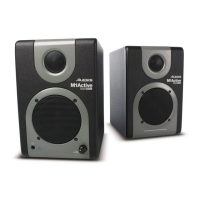Your First Session with the MidiVerb 4 Page: 4 Basic Connections Provides fundamental audio connection methods for getting the MidiVerb 4 operational with other audio equipment.
Powering Up Outlines the correct procedure for turning on the MidiVerb 4 system and initial checks.
Setting Levels Explains how to properly adjust input and output levels for optimal signal-to-noise ratio and to prevent distortion.
Whats in the Display? Details the different sections of the MidiVerb 4's display and their meanings during operation.
Changing Effect Settings Details how to enter edit mode and modify individual effect parameters within a selected program.
Using Online Help Introduces the built-in help system for understanding parameter functions directly from the display.
Special Cases Addresses specific editing scenarios, such as adjusting delay time parameters in detail.
Dry Defeat Describes the function to globally remove the direct (dry) signal from the unit's output.
Bypassing Effects Explains methods to bypass all effects, allowing only the dry signal to pass through the unit.
Connections Page: 18 AC Power Hookup Details the proper connection of the power adapter to the unit and an AC outlet for safe operation.
Audio Connections Provides guidelines for using high-quality cables and proper routing for optimal audio signal integrity.
Typical Applications Outlines common ways the MidiVerb 4 can be integrated into various studio setups and signal chains.
Input Jack Wiring Explains the normalled connection between the left and right input jacks and how it affects signal routing.
Using the Aux Sends Explains how to use a mixer's auxiliary sends to route signals to the MidiVerb 4 for effects processing.
Mono In - Stereo Out Describes connecting a mono input with stereo outputs for wider sound processing.
Dual Mono Explains how to process two separate mono signals independently through the unit.
Using Inserts Describes how to use mixer insert points to integrate the MidiVerb 4 into individual channel signal paths.
Using Main Outputs Explains how to connect the unit's main outputs to effect the entire mix or route to amplifiers.
Avoiding Ground Loops Offers practical advice and techniques to minimize hum and buzz caused by ground loops in audio systems.
MIDI Introduces MIDI functionality and its applications for controlling the MidiVerb 4.
Footswitch Describes the functions and setup of the rear-panel footswitch jack for hands-free control.
Overview of Effects Page: 27 What is a Configuration? Defines configurations as arrangements of effects and categorizes the types available in the unit.
Single Configuration Describes configurations using a single effect algorithm for optimal quality and performance.
Double Configuration Explains configurations using two 'side-by-side' mono-in/stereo-out effects, identified by a '+' symbol.
Dual Mono Configuration Describes configurations using two mono-in/mono-out effects, one for each channel, identified by a ':' symbol.
Multi Chain Configuration Details configurations that chain two or three stereo effects in series, identified by '->' symbols.
Reverb Effects Introduces the concept of reverberation and lists the various reverb types available on the MidiVerb 4.
Concert Hall Simulates the acoustics of a large concert hall, suitable for various instruments and vocals.
Real Room Replicates the sound of a medium-sized studio room with rich sound and smooth decay.
Realroom & Room Offers less processor-intensive versions of the Real Room effect for specific configurations.
Ambience Simulates a very small room, adding subtle ambient character to sounds.
Plate Reverb Recreates the sound of a classic plate reverb, known for its transparent tone on vocals and guitars.
Nonlinear Offers reverb with forward or backward directionality, including gated and reverse sounds.
Reverb Parameters Lists and describes the common control parameters for most reverb effects in the unit.
Decay Controls the duration of the reverb tail before it fades out.
Low Pass Filter Attenuates high frequencies above a set point, shaping the reverb's tonal character.
Pre-delay Introduces a slight delay before the reverb onset, helping the dry signal stand out.
Pre-delay Mix Balances the amount of pre-delay relative to the main reverb signal.
Density Controls the character of the reverb's first reflection and the overall 'thickness' of the sound.
Diffusion Determines the 'thickness' of the reverb by adding more reflections to the decay.
Reverberation Swirl Smooths reverb decay at low values or creates a detuning effect at high values.
Gating Abruptly cuts off reverb decay for a choppy sound, popular for drums.
Delay Effects Introduces delay effects, explaining how they create repetitions and detailing available types.
Mono Delay Provides single delay with adjustable time, feedback, and EQ for classic echo sounds.
Stereo Delay Offers two independent delays with adjustable parameters for stereo echo effects.
Ping Pong Delay Creates a bouncing stereo delay effect, panning echoes between left and right channels.
MultiTap Delay Combines three delays with individual controls for creating complex rhythmic patterns.
BPM Mono Delay A mono delay that synchronizes its time to an external MIDI clock or tap tempo.
Pitch Effects Covers effects that alter the pitch of a signal to create layered timbres and harmonies.
Stereo Chorus Creates a shimmering, detuned sound by modulating pitch with an LFO for left and right channels.
Quad Chorus Modulates four delayed signals with phase offsets for phasing and chorus effects.
Chorus A mono version of the stereo chorus effect for less intensive processing.
Stereo Flange Simulates the classic flanging effect, creating a 'jet airplane' sound by modulating delay times.
Flange A mono version of the stereo flange effect, producing a swishing or tunneling sound.
Lezlie Simulates a rotating speaker effect, often used with organs for complex timbral changes.
Stereo Pitch Shifter Transposes pitch by fixed amounts, useful for harmonies, detuning, and special effects.
Pitch A less processor-intensive version of the stereo pitch shifter.
Auto Pan Alternates signal loudness between channels, creating a panning effect.
Description of Controls Page: 44 LCD Display Explains the different sections and information displayed on the unit's liquid crystal display.
BYPASS LED Indicator Describes the function of the bypass LED, indicating when the unit is in bypass mode.
VALUE Knob Explains the use of the value knob for adjusting parameters, scrolling programs, and editing values.
PROGram Button Details the function of the program button for selecting program mode, scrolling programs, and toggling banks.
EDIT;PAGE Button Describes how the edit/page button is used to enter edit mode and navigate through parameter pages.
A;B;C;D Buttons Explains the function of the A/B/C/D buttons for parameter selection, editing, and program naming.
UTILity Button Details the utility button's function for accessing and navigating through various utility pages and settings.
STORE Button Explains the store button's role in saving edited programs and copying them to different locations.
Auto Level Function Introduces the auto level function for automatically setting optimal input levels.
Power Connector Details the connection of the power supply and the importance of using the correct adapter.
Footswitch Jack Explains the functions of the footswitch jack for bypassing effects or advancing programs.
MIDI Ports Describes the MIDI In and Out/Thru ports for MIDI data communication.
Audio Input Jacks Describes the 1/4" input jacks for connecting audio sources to the unit.
Audio Output Jacks Describes the 1/4" output jacks for connecting the processed audio to amplifiers or mixers.
Effect Parameters Chart Introduces a chart that maps configuration parameters to specific pages and buttons for editing.
MIDI Applications Page: 58 MIDI Functions Outlines the various MIDI capabilities of the MidiVerb 4, including program changes and Sysex.
MIDI Channel Explains how to set the MIDI channel for receiving program change and other MIDI messages.
MIDI Thru Describes how to route MIDI data from the IN port to the OUT/THRU port for passing information to other devices.
Program Change Table Explains how to remap incoming MIDI program change messages to specific MidiVerb 4 programs.
Sysex Storage Guides users on sending and receiving program data via System Exclusive (Sysex) dumps.
Specifications Page: 67 Electrical Details the electrical specifications, including frequency response, dynamic range, and distortion.
Input Lists specifications related to the unit's audio inputs, such as channel count and impedance.
A;D - D;A Conversions Provides details on the analog-to-digital and digital-to-analog conversion processes, including processor speed and bit depth.
Output Lists specifications for the unit's audio outputs, including channel count and maximum level.
Rear Panel Details the specifications of the connectors and ports on the unit's rear panel.
Processing and Memory Lists specifications related to the unit's processing capabilities and memory, including program types and effect configurations.
Your First Session with the MidiVerb 4 Page: 4 Basic Connections Provides fundamental audio connection methods for getting the MidiVerb 4 operational with other audio equipment.
Powering Up Outlines the correct procedure for turning on the MidiVerb 4 system and initial checks.
Setting Levels Explains how to properly adjust input and output levels for optimal signal-to-noise ratio and to prevent distortion.
Whats in the Display? Details the different sections of the MidiVerb 4's display and their meanings during operation.
Changing Effect Settings Details how to enter edit mode and modify individual effect parameters within a selected program.
Using Online Help Introduces the built-in help system for understanding parameter functions directly from the display.
Special Cases Addresses specific editing scenarios, such as adjusting delay time parameters in detail.
Dry Defeat Describes the function to globally remove the direct (dry) signal from the unit's output.
Bypassing Effects Explains methods to bypass all effects, allowing only the dry signal to pass through the unit.
Connections Page: 18 AC Power Hookup Details the proper connection of the power adapter to the unit and an AC outlet for safe operation.
Audio Connections Provides guidelines for using high-quality cables and proper routing for optimal audio signal integrity.
Typical Applications Outlines common ways the MidiVerb 4 can be integrated into various studio setups and signal chains.
Input Jack Wiring Explains the normalled connection between the left and right input jacks and how it affects signal routing.
Using the Aux Sends Explains how to use a mixer's auxiliary sends to route signals to the MidiVerb 4 for effects processing.
Mono In - Stereo Out Describes connecting a mono input with stereo outputs for wider sound processing.
Dual Mono Explains how to process two separate mono signals independently through the unit.
Using Inserts Describes how to use mixer insert points to integrate the MidiVerb 4 into individual channel signal paths.
Using Main Outputs Explains how to connect the unit's main outputs to effect the entire mix or route to amplifiers.
Avoiding Ground Loops Offers practical advice and techniques to minimize hum and buzz caused by ground loops in audio systems.
MIDI Introduces MIDI functionality and its applications for controlling the MidiVerb 4.
Footswitch Describes the functions and setup of the rear-panel footswitch jack for hands-free control.
Overview of Effects Page: 27 What is a Configuration? Defines configurations as arrangements of effects and categorizes the types available in the unit.
Single Configuration Describes configurations using a single effect algorithm for optimal quality and performance.
Double Configuration Explains configurations using two 'side-by-side' mono-in/stereo-out effects, identified by a '+' symbol.
Dual Mono Configuration Describes configurations using two mono-in/mono-out effects, one for each channel, identified by a ':' symbol.
Multi Chain Configuration Details configurations that chain two or three stereo effects in series, identified by '->' symbols.
Reverb Effects Introduces the concept of reverberation and lists the various reverb types available on the MidiVerb 4.
Concert Hall Simulates the acoustics of a large concert hall, suitable for various instruments and vocals.
Real Room Replicates the sound of a medium-sized studio room with rich sound and smooth decay.
Realroom & Room Offers less processor-intensive versions of the Real Room effect for specific configurations.
Ambience Simulates a very small room, adding subtle ambient character to sounds.
Plate Reverb Recreates the sound of a classic plate reverb, known for its transparent tone on vocals and guitars.
Nonlinear Offers reverb with forward or backward directionality, including gated and reverse sounds.
Reverb Parameters Lists and describes the common control parameters for most reverb effects in the unit.
Decay Controls the duration of the reverb tail before it fades out.
Low Pass Filter Attenuates high frequencies above a set point, shaping the reverb's tonal character.
Pre-delay Introduces a slight delay before the reverb onset, helping the dry signal stand out.
Pre-delay Mix Balances the amount of pre-delay relative to the main reverb signal.
Density Controls the character of the reverb's first reflection and the overall 'thickness' of the sound.
Diffusion Determines the 'thickness' of the reverb by adding more reflections to the decay.
Reverberation Swirl Smooths reverb decay at low values or creates a detuning effect at high values.
Gating Abruptly cuts off reverb decay for a choppy sound, popular for drums.
Delay Effects Introduces delay effects, explaining how they create repetitions and detailing available types.
Mono Delay Provides single delay with adjustable time, feedback, and EQ for classic echo sounds.
Stereo Delay Offers two independent delays with adjustable parameters for stereo echo effects.
Ping Pong Delay Creates a bouncing stereo delay effect, panning echoes between left and right channels.
MultiTap Delay Combines three delays with individual controls for creating complex rhythmic patterns.
BPM Mono Delay A mono delay that synchronizes its time to an external MIDI clock or tap tempo.
Pitch Effects Covers effects that alter the pitch of a signal to create layered timbres and harmonies.
Stereo Chorus Creates a shimmering, detuned sound by modulating pitch with an LFO for left and right channels.
Quad Chorus Modulates four delayed signals with phase offsets for phasing and chorus effects.
Chorus A mono version of the stereo chorus effect for less intensive processing.
Stereo Flange Simulates the classic flanging effect, creating a 'jet airplane' sound by modulating delay times.
Flange A mono version of the stereo flange effect, producing a swishing or tunneling sound.
Lezlie Simulates a rotating speaker effect, often used with organs for complex timbral changes.
Stereo Pitch Shifter Transposes pitch by fixed amounts, useful for harmonies, detuning, and special effects.
Pitch A less processor-intensive version of the stereo pitch shifter.
Auto Pan Alternates signal loudness between channels, creating a panning effect.
Description of Controls Page: 44 LCD Display Explains the different sections and information displayed on the unit's liquid crystal display.
BYPASS LED Indicator Describes the function of the bypass LED, indicating when the unit is in bypass mode.
VALUE Knob Explains the use of the value knob for adjusting parameters, scrolling programs, and editing values.
PROGram Button Details the function of the program button for selecting program mode, scrolling programs, and toggling banks.
EDIT;PAGE Button Describes how the edit/page button is used to enter edit mode and navigate through parameter pages.
A;B;C;D Buttons Explains the function of the A/B/C/D buttons for parameter selection, editing, and program naming.
UTILity Button Details the utility button's function for accessing and navigating through various utility pages and settings.
STORE Button Explains the store button's role in saving edited programs and copying them to different locations.
Auto Level Function Introduces the auto level function for automatically setting optimal input levels.
Power Connector Details the connection of the power supply and the importance of using the correct adapter.
Footswitch Jack Explains the functions of the footswitch jack for bypassing effects or advancing programs.
MIDI Ports Describes the MIDI In and Out/Thru ports for MIDI data communication.
Audio Input Jacks Describes the 1/4" input jacks for connecting audio sources to the unit.
Audio Output Jacks Describes the 1/4" output jacks for connecting the processed audio to amplifiers or mixers.
Effect Parameters Chart Introduces a chart that maps configuration parameters to specific pages and buttons for editing.
MIDI Applications Page: 58 MIDI Functions Outlines the various MIDI capabilities of the MidiVerb 4, including program changes and Sysex.
MIDI Channel Explains how to set the MIDI channel for receiving program change and other MIDI messages.
MIDI Thru Describes how to route MIDI data from the IN port to the OUT/THRU port for passing information to other devices.
Program Change Table Explains how to remap incoming MIDI program change messages to specific MidiVerb 4 programs.
Sysex Storage Guides users on sending and receiving program data via System Exclusive (Sysex) dumps.
Specifications Page: 67 Electrical Details the electrical specifications, including frequency response, dynamic range, and distortion.
Input Lists specifications related to the unit's audio inputs, such as channel count and impedance.
A;D - D;A Conversions Provides details on the analog-to-digital and digital-to-analog conversion processes, including processor speed and bit depth.
Output Lists specifications for the unit's audio outputs, including channel count and maximum level.
Rear Panel Details the specifications of the connectors and ports on the unit's rear panel.
Processing and Memory Lists specifications related to the unit's processing capabilities and memory, including program types and effect configurations.


